|
 Camarophyllus pratensis var. gracilis Camarophyllus pratensis var. gracilis
SynonymsHygrophorus pratensis
BiostatusPresent in region - Indigenous. Endemic
Images (click to enlarge)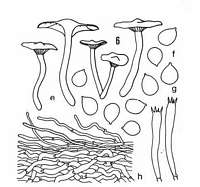
Caption: Camarophyllus pratensis var gracilis Hk. (type): e. carpophores. - f spores. - g. basidia. - h. cuticle | 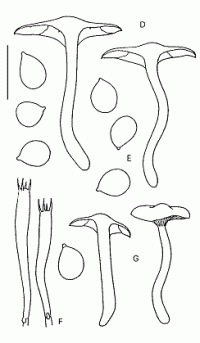
Caption: Fig. 23 Camarophyllus pratensis var. gracilis Horak (D-F: PDD
27074, type): D. basidiomes. E. spores. F. basidia (ZF 890): G. basidiomes. | 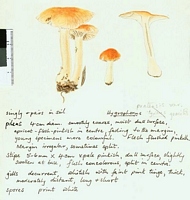
Caption: Watercolour
Owner: G.M. Taylor | 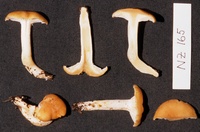
Caption: ZT9431, NZ-165
Owner: E. Horak: © Creative Commons Attribution-Noncommercial 3.0 New Zealand | 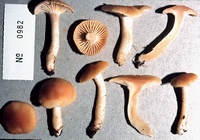
Caption: ZT0982
Owner: E. Horak: © Creative Commons Attribution-Noncommercial 3.0 New Zealand | 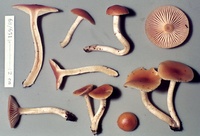
Caption: ZT68-651 , Holotype
Owner: E. Horak: © Creative Commons Attribution-Noncommercial 3.0 New Zealand | 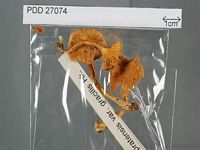
Caption: Dried type specimen
Owner: Herb PDD | 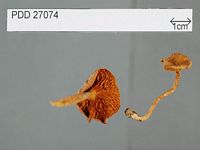
Caption: Dried type specimen
Owner: Herb PDD | |
Article: Horak, E. (1990). Monograph of the New Zealand Hygrophoraceae (Agaricales). New Zealand Journal of Botany 28(3): 255-306 (http://www.rsnz.org/publish/abstracts.php).
Description: Pileus -40 mm, hemispherical to convex, later expanded with ± distinct low
umbo, margin not upturned; brilliant orange to apricot with brown tinge, darker
at centre, opaque; dry, glabrous to minutely fibrillose, margin non-striate,
slightly hygrophanous. - Lamellae 15-20 (l -3) decurrent; whitish to concolorous
with pileus, obtuse edges entire, often intervenose. - Stipe 15-50 x 2-5 mm,
cylindrical, equal or tapering at base; whitish to pale orange; dry, minutely
fibrillose, occasionally with strigose base, solid becoming hollow, single or
caespitose. – Context brilliant orange beneath cuticle of pileus, otherwise
pale orange or whitish. - Odour and taste not distinctive. - Chemical reactions
on pileus: KOH, HCl, and NH3 - negative.
Spores 5-6.5 x 4-5 um, subglobose to ovoid, apiculus distinct -Basidia 30-50
x 4-6 um, 4-spored. - cystidia absent. - Pileipellis a cutis of interwoven,
cylindrical hyphae (3-7 um diam.), membrane not gelatinised, minutely encrusted
with pigment; clamp connections present (Pl. 1, Fig. 5).
Habitat: ECOLOGY: Scattered; saprobic among litter in broadleaved-conifer forests (Leptospermum
scoparium, Beilschmiedia tawa, Agathis, Podocarpus, Phyllocladus, Dacrydium,
Cyathea). June-July.
Distribution: DISTRIBUTION: NZ (NA, SA).
Article: Horak, E. (1973). Fungi Agaricini Novazelandiae I-V. Beihefte zur Nova Hedwigia 43: 200 p.
Description: Pileus 10-40 mm broad, convex then more or less expanded, umbonate from the very beginning, deep orange to apricot brown, darker at the centre, margin not upturned, estriate, not hygrophanous, dry, minutely fibrillose under a lens. Lamellae decurrent, whitish or concolorous with pileus, gill edge even, intervenose. Stipe 15-50 x 2-4 mm, cylindric, equal, concolorous with pileus and lamellae or paler, dry, minutely fibrillose, hollow, single or grown together. Context deep orange beneath the cuticle. Taste and odor not distinctive. Chemical reactions on Pileus: KOH, HCl and NH3 - negative.
Spores 5.5-6.5 x 4.5-5 µm, subglobose to ovoid, smooth, inamyloid. Basidia 35-46 x 4-5 µm, 4-spored. Cystidia absent. Trama of lamellae intricately interwoven. Cuticle a cutis of loosely interwoven, cylindric, not gelatinized hyphae (3-7 µm diam.), pigment encrusted. Clamp connections numerous.
Habitat: On soil under Phyllocladus trichomanoides, Dacrydium cupressinum., Cyathea, etc. New Zealand.
Notes: This variety differs from the type in its deeper colours and its pronounced umbo on the pileus, the slender habit of the carpophores and the smaller spores.
|